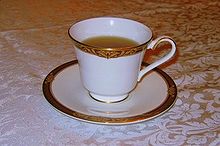Saucer
This article needs additional citations for verification. (December 2012) |


A saucer is a type of small dishware. While in the Middle Ages a saucer was used for serving condiments and sauces,[1] currently the term is used to denote a small plate or shallow bowl that supports a cup – usually one used to serve coffee or tea (see teacup). The center of the saucer often contains a depression sized to fit a matching cup; this depression is sometimes raised, and antique saucers may omit it altogether. The saucer is useful for protecting surfaces from possible damage due to the heat of a cup, and to catch overflow, splashes, and drips from the cup, thus protecting both table linen and the user sitting in a free-standing chair who holds both cup and saucer. The saucer also provides a convenient place for a damp spoon, as might be used to stir the drink in the cup in order to mix sweeteners or creamers into tea or coffee. Some people pour the hot tea or coffee from the cup into the saucer;[2] the increased surface area of the liquid exposed to the air increases the rate at which it cools, allowing the drinker to consume the beverage quickly after preparation. Although often part of a place setting in a dinner set, teacups with unique styling are often sold with matching saucers, sometimes alone, or as part of a tea set, including a teapot and small dessert plates. A set of four is typical for a tea set.
Saucers have very little direct influence on beverage cooling rate: cups typically have low contact area with the saucer, so the heat transfer rate is low.
For hot, water based beverages (e.g. tea or coffee), cooling rate in a cup is typically dominated by evaporation, which occurs across the free surface in contact with the air. Placing a saucer on top of a cup prevents such evaporative cooling taking place and is thus an effective way of reducing the cooling rate so that the drink remains warmer for longer. The reduction in heat loss due to evaporation is typically much greater than the increase in heat loss associated with conduction through the saucer (and subsequent radiation or convective transfer to the surrounding air).
Saucer gallery
-
Department store-ware
-
styrofoam saucer
-
antique
-
Faience saucer of the Maison Losseau collections.
See also
- Coaster, used to protect the surface where the user might place a beverage
- Demitasse
- 茶托(pinyin: chátuō/(Japanese: Chataku)(zh:茶托/ja:茶托) - case of Chawan
References




